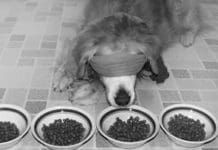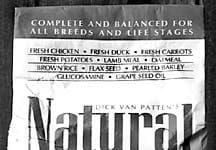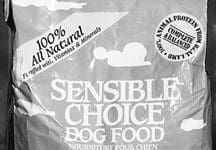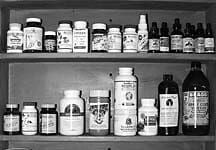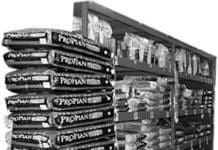The Ancestral Dog Food Diet
Dog food as we know it today that is, either crumbly bits of kibble packaged in bags and boxes or gloopy meat-based concoctions sealed into cans was invented in 1860. Think about that for a moment. Our great-grandparents and great-great-grandparents raised dogs completely without the benefit of Purina. Before 1860, no one poured a pile of chow from a bag marked, Dog." Everyone who had a dog knew what dogs ate and how to feed them. "
Finding The Best Dog Foods on The Market
The maker of Health Food For Dogs, Breeder’s Choice of Irwindale, California, has a much better food on the market: Pinnacle, one of our favorite foods. Despite the optimistic name and cold claims on the front label (“Finest Meats & Grains . . . Nutritionally Superior”) this entry falls somewhere in the middle of their offerings in terms of quality; they have better, they have worse. We far prefer the use of chicken meal to their mixed ingredient “poultry meal,” especially as a number one ingredient, but appreciate the use of lamb meal and fish meal to offer a rounded complement of amino acids.
Hidden Killers in Dog Food
I own a beautiful German Shepherd named Xeus. He comes from very well-known, healthy, wonderful lines. Xeus is sound, has personality galore and a wonderful temperament – he’s just an all-around great German Shepherd. One Saturday in late June 1999, a really nice, hot summer day, my entire family was hanging out in our back yard, enjoying our pool, as we watched Xeus enjoy his kiddie pool. All of a sudden, Xeus jumped out of his wading pool and made a bee-line for the house. I watched him go in, thinking he was just looking for another toy to bring out, but he didn’t come back out.
Natural Balance Dog Food
We selected Natural Balance as a Top Dry Food in our February 2000 issue, but the food was recently reformulated and bears almost no resemblance to its former self. This incarnation is very impressive. The food now has three major protein sources – chicken (appearing first on the list of ingredients), duck (number third), and lamb meal (fourth), providing a nice complement of amino acids. The makers have also omitted corn, soy, wheat, eggs, white rice, dairy products, and sunflower oil from the food, in an effort to avoid many ingredients that allergic dogs have problems with. Like many companies jumping on the nutraceutical bandwagon, NB has included glucosamine (beneficial for arthritic conditions) and extra vitamin C (for general immune health) in the food. However, without any information as to the amount present in the food, there is no way to say whether the inclusion is at all beneficial.
When it Comes to Dog Food – What Does the Term “Natural” Really Mean?
Maybe it’s partially our fault, but the word “natural” is getting a lot of exposure on dog food labels these days. The problem is, it doesn’t mean anything in particular; there is no official definition of the word. It just sounds good, and companies like Pet Products Plus, Inc., makers of Sensible Choice, like to use it a lot. A bright yellow banner on the front of the bag says, “100% All Natural.” And the back of the label explains, “Sensible Choice dog foods are all-natural products. . . In other words, if it’s not found in nature, you won’t find it in Sensible Choice.” But that just doesn’t explain something like “natural flavor,” the sixth ingredient listed on the label of the Sensible Choice Lamb and Rice food. Natural what flavor?
Information on Our Dog Food Reviews
We’ve had a LOT of mail, email, and phone calls since we published our dry dog food review last month, mostly from people who wanted more information. We are thrilled that people are finally learning to be concerned with the food their dogs eat. We’re also pleased that a large percentage (perhaps a full three-quarters) of the people who contacted us asked, “What about the three foods that were on your list last year (Beowulf’s Back to Basics, Solid Gold’s Hund ‘N Flocken, and Wysong) that weren’t on your list this year?” What loyal readers! You guys are all over it! To answer the question for all three foods: They still meet all our criteria; they are still good foods. We like them! We like them! We really like them!
Choosing Canine Supplements Wisely
Sometimes, the deficiency is discovered when a blood test is performed for the purpose of analyzing the dog’s nutritional status (although, in my opinion, there are some problems with this methodology (see “Blood Testing for Deficiencies,” next page). In other cases, a dog owner might know that the diet he feeds is deficient in a certain nutrient, and he supplements rather than changes the formulation of the diet. For example, dogs who are fed a diet based on raw meats and vegetables, but who don’t receive fresh ground bones, are more than likely to be deficient in calcium.
Labeling Dog Food Just Like People Food!
We’ve been whining lately about the dog food industry’s reluctance to embrace and use a “date of manufacture” on their product labels. There is no argument that fresher foods are better foods; with time, vitamins degrade, oils go stale and become rancid, and molds may develop, no matter what sort of preservatives are used. But the big pet food makers would rather concentrate on making their foods last as long as possible – extending shelf life with preservatives, keeping oxygen out of the food with cutting-edge technology bags, etc. – than working out a distribution system that gets their products into the bowls of consumers faster.
Who’s in Charge of Pet Food Manufacturing Regulations?
While most dog owners are certain that “someone” is in charge of regulating the manufacture of commercial dog food in this country, very few people know who that mysterious official or agency might be. But somebody’s gotta be making sure that dog food doesn’t contain any harmful ingredients and does contain what dogs need to survive, right? The FDA? Department of Agriculture? Someone?
Does Your Dog Eat Grass?
radish sprouts
Just Because Your Dog Has a Favorite Food Doesn’t Make It Nutritious!
There are hundreds of brands and flavors of dog food out there. You can find them everywhere, from the corner convenience store to the members-only warehouse center to the hard-to-find health food store for pets. And by golly, you’ve tried what seems like all of them! Yet you’re still not sure which are the best ones for your dog. On the other hand, your dog seems to have a definite opinion about it, and really prefers one of the less expensive grocery store brands. That’s great, you think, he loves the food and he’s saving me money! But is he? Is your dog’s preference for a particular food a good indication of the quality of the food?
Canned Dog Food or Dry Dog Food? We’ll Help Break it Down
Caring guardians of companion canines often wonder whether one form of commercially prepared food – kibble or canned – is better than the other. The truth is, both types of food have relative advantages and disadvantages in terms of palatability, digestibility, and necessity for preservatives or other chemical additives. While they generally meet the same chemical composition standards in terms of vitamins, minerals, and amino acids, these types of food provide very different nutritional value.








